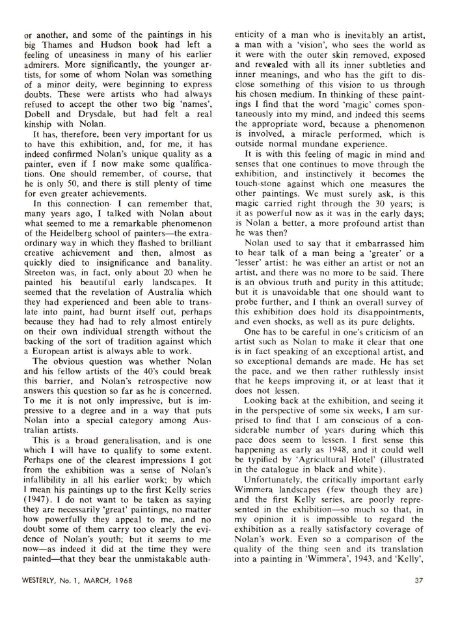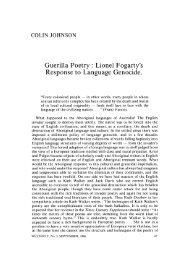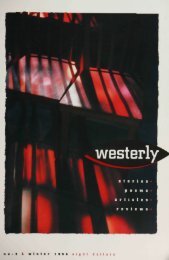You also want an ePaper? Increase the reach of your titles
YUMPU automatically turns print PDFs into web optimized ePapers that Google loves.
or another, and some of the paintings in hisbig Thames and Hudson book had left afeeling of uneasiness in many of his earlieradmirers. More significantly, the younger artists,for some of whom Nolan was somethingof a minor deity, were beginning to expressdoubts. These were artists who had alwaysrefused to accept the other two big 'names',Dobell and Drysdale, but had felt a realkinship with Nolan.It has, therefore, been very important for usto have this exhibition, and, for me, it hasindeed confirmed Nolan's unique quality as apainter, even if I now make some qualifications.One should remember, of course, thathe is only 50, and there is still plenty of timefor even greater achievements.In this connection- I can remember that,many years ago, I talked with Nolan aboutwhat seemed to me a remarkable phenomenonof the Heidelberg school of painters—the extraordinaryway in which they flashed to brilliantcreative achievement and then, almost asquickly died to insignificance and banality.Streeton was, in fact, only about 20 when hepainted his beautiful early landscapes. Itseemed that the revelation of Australia whichthey had experienced and been able to translateinto paint, had burnt itself out, perhapsbecause they had had to rely almost entirelyon their own individual strength without thebacking of the sort of tradition against whicha European artist is always able to work.The obvious question was whether Nolanand his fellow artists of the 40's could breakthis barrier, and Nolan's retrospective nowanswers this question so far as he is concerned.To me it is not only impressive, but is impressiveto a degree and in a way that putsNolan into a special category among Australianartists.This is a broad generalisation, and is onewhich I will have to qualify to some extent.Perhaps one of the clearest impressions I gotfrom the exhibition was a sense of Nolan'sinfallibility in all his earlier work; by whichI mean his paintings up to the first Kelly series(1947). I do not want to be taken as sayingthey are necessarily 'great' paintings, no matterhow powerfully they appeal to me, and nodoubt some of them carry too clearly the evidenceof Nolan's youth; but it seems to menow—as indeed it did at the time they werepainted—that they bear the unmistakable authenticityof a man who is inevitably an artist,a man with a 'vision', who sees the world asit were with the outer skin removed, exposedand revealed with all its inner subtleties andinner meanings, and who has the gift to disclosesomething of this vision to us throughhis chosen medium. In thinking of these paintingsI find that the word 'magic' comes spontaneouslyinto my mind, and indeed this seemsthe appropriate word, because a phenomenonis involved, a miracle performed, which isoutside normal mundane experience.It is with this feeling of magic in mind andsenses that one continues to move through theexhibition, and instinctively it becomes thetouch-stone against which one measures theother paintings. We must surely ask, is thismagic carried right through the 30 years; isit as powerful now as it was in the early days;is Nolan a better, a more profound artist thanhe was then?Nolan used to say that it embarrassed himto hear talk of a man being a 'greater' or a'lesser' artist: he was either an artist or not anartist, and there was no more to be said. Thereis an obvious truth and purity in this attitude;but it is unavoidable that one should want toprobe further, and I think an overall survey ofthis exhibition does hold its disappointments,and even shocks, as well as its pure delights.One has to be careful in one's criticism of anartist such as Nolan to make it clear that oneis in fact speaking of an exceptional artist, andso exceptional demands are made. He has setthe pace, and we then rather ruthlessly insistthat he keeps improving it, or at least that itdoes not lessen.Looking back at the exhibition, and seeing itin the perspective of some six weeks, I am surprisedto find that I am conscious of a considerablenumber of years during which thispace does seem to lessen. I first sense thishappening as early as 1948, and it could wellbe typified by 'Agricultural Hotel' (illustratedin the catalogue in black and white).Unfortunately, the critically important earlyWimmera landscapes (few though they are)and the first Kelly series, are poorly representedin the exhibition—so much so that, inmy opinion it is impossible to regard theexhibition as a really satisfactory coverage ofNolan's work. Even so a comparison of thequality of the thing seen and its translationinto a painting in 'Wimmera', 1943, and 'Kelly',WESTERLY, No. 1, MARCH, 1 968 37







